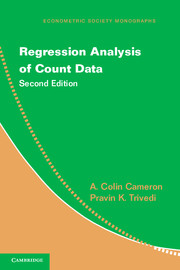Book contents
- Frontmatter
- Dedication
- Contents
- List of Figures
- List of Tables
- Preface
- Preface to the First Edition
- 1 Introduction
- 2 Model Specification and Estimation
- 3 Basic Count Regression
- 4 Generalized Count Regression
- 5 Model Evaluation and Testing
- 6 Empirical Illustrations
- 7 Time Series Data
- 8 Multivariate Data
- 9 Longitudinal Data
- 10 Endogenous Regressors and Selection
- 11 Flexible Methods for Counts
- 12 Bayesian Methods for Counts
- 13 Measurement Errors
- A Notation and Acronyms
- B Functions, Distributions, and Moments
- C Software
- References
- Author Index
- Subject Index
- Miscellaneous Endmatter
7 - Time Series Data
Published online by Cambridge University Press: 05 July 2014
- Frontmatter
- Dedication
- Contents
- List of Figures
- List of Tables
- Preface
- Preface to the First Edition
- 1 Introduction
- 2 Model Specification and Estimation
- 3 Basic Count Regression
- 4 Generalized Count Regression
- 5 Model Evaluation and Testing
- 6 Empirical Illustrations
- 7 Time Series Data
- 8 Multivariate Data
- 9 Longitudinal Data
- 10 Endogenous Regressors and Selection
- 11 Flexible Methods for Counts
- 12 Bayesian Methods for Counts
- 13 Measurement Errors
- A Notation and Acronyms
- B Functions, Distributions, and Moments
- C Software
- References
- Author Index
- Subject Index
- Miscellaneous Endmatter
Summary
INTRODUCTION
The previous chapters have focused on models for cross-section regression on a single count dependent variable. We now turn to models for more general types of data – univariate time series data in this chapter, multivariate cross-section data in Chapter 8, and longitudinal or panel data in Chapter 9.
Count data introduce complications of discreteness and heteroskedasticity. For cross-section data, this leads to moving from the linear model to the Poisson regression model. However, this model is often too restrictive when confronted with real data, which are typically overdispersed. With cross-section data, overdispersion is most frequently handled by leaving the conditional mean unchanged and rescaling the conditional variance. The same adjustment is made regardless of whether the underlying cause of overdispersion is unobserved heterogeneity in a Poisson point process or true contagion leading to dependence in the process.
For time series count data, one can again begin with the Poisson regression model. In this case, however, it is not clear how to proceed if dependence is present. For example, developing even a pure time series count model where the count in period t, yt, depends only on the count in the previous period, yt−1, is not straightforward, and there are many possible ways to proceed. Even restricting attention to a fully parametric approach, one can specify distributions for yt either conditional on yt−1 or unconditional on yt−1. For count data this leads to quite different models, whereas for continuous data the assumption of joint normality leads to both conditional and marginal distributions that are also normal.
- Type
- Chapter
- Information
- Regression Analysis of Count Data , pp. 263 - 303Publisher: Cambridge University PressPrint publication year: 2013

